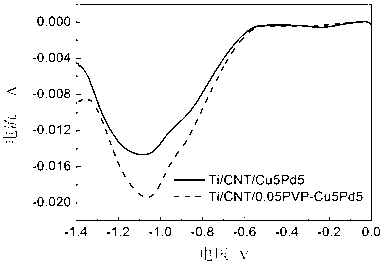Carbon nano tube film load cuprum and palladium bimetallic catalyst, preparation method and application
A technology of bimetallic catalyst and carbon nanotube film, which is applied in chemical instruments and methods, water/sewage treatment, water/sludge/sewage treatment, etc., can solve the problems of high cost and time-consuming, and achieve good mechanical properties, Good electrical performance and the effect of improving electrochemical activity
- Summary
- Abstract
- Description
- Claims
- Application Information
AI Technical Summary
Problems solved by technology
Method used
Image
Examples
Embodiment 1
[0021] 1) Take 0.2 g of carbon nanotubes and place them in a mixed concentrated acid with the ratio of concentrated sulfuric acid and concentrated nitric acid at a ratio of 3:1, ultrasonicate at a constant temperature of 60 °C for 8 h, wash and filter with deionized water until the pH value of the filtrate is neutral, and dry at low temperature. Obtain functional grouped carbon nanotube materials; ultrasonically disperse in deionized water, and obtain 100 mL of carbon nanotube suspension at constant volume, the concentration of carbon nanotubes in the suspension is about 2 mg / L;
[0022] 2) The titanium plate was polished until the surface showed a uniform light gray luster; the polished titanium plate was washed with 50 wt% NaOH alkali at 70 °C for 1 h to remove the surface oil; the alkali-washed titanium plate was used at 80 °C Pickling with 20 wt% oxalic acid for 2 h to remove surface TiO 2 ;
[0023] 3) The titanium plate pretreated in step 2) was used as the anode, the P...
Embodiment 2
[0027] 1) Take 0.2 g of carbon nanotubes and place them in a mixed concentrated acid with the ratio of concentrated sulfuric acid and concentrated nitric acid at a ratio of 3:1, ultrasonicate at a constant temperature of 70 °C for 6 h, wash and filter with deionized water until the pH value of the filtrate is neutral, and dry at low temperature. Obtain functional grouped carbon nanotube materials; ultrasonically disperse in deionized water, and obtain 100 mL of carbon nanotube suspension at constant volume, the concentration of carbon nanotubes in the suspension is about 2 mg / L;
[0028] 2) The titanium plate was polished until the surface showed a uniform light gray luster; the polished titanium plate was washed with 30 wt% NaOH alkali at 90 °C for 2 h to remove surface oil; the titanium plate after alkali washing was used at 95 °C Pickling with 10 wt% oxalic acid for 4 h to remove surface TiO 2 ;
[0029] 3) The titanium plate pretreated in step 2) was used as the anode, th...
Embodiment 3
[0033] 1) Take 0.2 g of carbon nanotubes and place them in a mixed concentrated acid with the ratio of concentrated sulfuric acid and concentrated nitric acid at a ratio of 3:1, ultrasonicate at a constant temperature of 65 °C for 7 h, wash and filter with deionized water until the pH value of the filtrate is neutral, and dry at low temperature. Obtain functional grouped carbon nanotube materials; ultrasonically disperse in deionized water, and obtain 100 mL of carbon nanotube suspension at constant volume, the concentration of carbon nanotubes in the suspension is about 2 mg / L;
[0034] 2) The titanium plate was polished until the surface showed a uniform light gray luster; the polished titanium plate was washed with 40 wt% NaOH alkali at 80 °C for 1.5 h to remove surface oil; the titanium plate after alkali washing was used at 90 °C Pickling with 15 wt% oxalic acid for 3 h to remove surface TiO 2 ;
[0035] 3) The titanium plate pretreated in step 2) was used as the anode, ...
PUM
| Property | Measurement | Unit |
|---|---|---|
| concentration | aaaaa | aaaaa |
Abstract
Description
Claims
Application Information
 Login to View More
Login to View More - R&D
- Intellectual Property
- Life Sciences
- Materials
- Tech Scout
- Unparalleled Data Quality
- Higher Quality Content
- 60% Fewer Hallucinations
Browse by: Latest US Patents, China's latest patents, Technical Efficacy Thesaurus, Application Domain, Technology Topic, Popular Technical Reports.
© 2025 PatSnap. All rights reserved.Legal|Privacy policy|Modern Slavery Act Transparency Statement|Sitemap|About US| Contact US: help@patsnap.com

